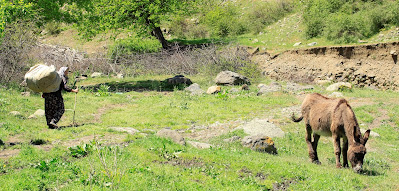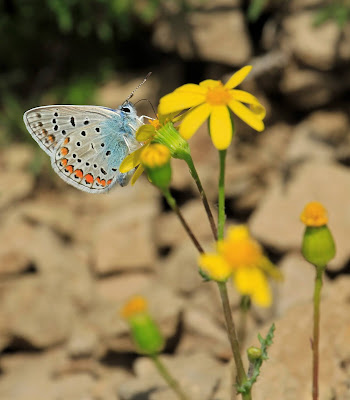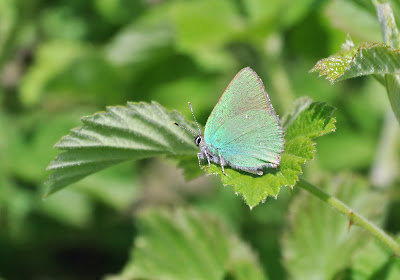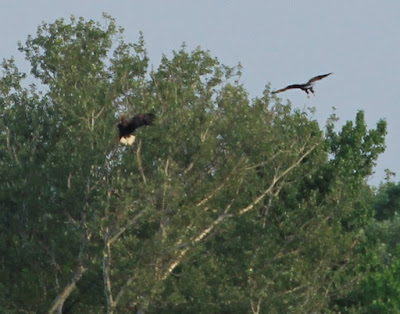From the capital Sofia, we drove south-east to Plovdiv - the Ancient Greek city of Philippopolis, though now more famous for its more recent Roman ruins.
Then on to the Rhodope mountains, to an area around the Studen Kladenets reservoirs near the border with Greece.
Then on to the Rhodope mountains, to an area around the Studen Kladenets reservoirs near the border with Greece.
Steve was on butterfly duty, and it wasn't long before he came across this beauty by the roadside - a Southern Festoon (Zerynthia polyxena). It is found from southern Europe to the Urals but is a rare find, maybe because it lays its eggs specifically on Birthwort vines (or Dutchman's Pipes) of the genus Aristolochia - plants famous for imprisoning flies which enter their flowers to achieve pollination. These plants also contain a toxin, which is extracted by the caterpillars and makes them inedible to predators. There is a darker and more colourful sub-species found in south-east France.
After that, Steve couldn't stop spotting butterflies. The Wood White (Leptidia sinapis) is found all over the Palearctic. It likes to lay its eggs on Birdsfoot Trefoil.
The Blues were abundant. The Chequered Blue (Scolitantides orion), with its chequered wing fringe, is also found throught the Palearctic - here the nominal sub-species found in eastern Europe.
A Green-underside Blue (Glaucopsyche alexis) shows off its greeny-blue underside. It is found on Vetch.
A few years ago I would have called this a Zephyr Blue (Kretania pylaon). But now a number of its sub-species are considered distinct species. The populations in Bulgaria now belong to the eastern European K. sephirus species. The larvae feed on Astragalus Milkvetch, and are myrmecophilous - that is, tended by ants which feed on their exudates.
The wonderful Glanville Fritillary (Melitaea cinxia).
...and Little Bittern (Ixobrychus minutis).
European Pond Turtles (Emys orbicularis) find a home here. They are endangered in western Europe - but in Bulgaria are revered enough to have their own stamp.
A Common Blue (Polyommatus icarus).
Not all Blues are blue. The Small Copper (Lycaena phlaeas), another Rumex specialist, has a very broad holarctic distribution from the US, Europe and Asia - resulting in no less than twenty-four sub-species being recognised in a complex taxonomy. Here it is the nominal form.
A male Sooty Copper (Lycaena tityrus), a Rumex specialist.
A Brown Argus (Aricia agestis).
The Green Hairstreak (Callophrys rubi) is also a non-blue Blue, with a green underside (and brown upperside).
Representing the Satyrines, a grass-feeding Small Heath (Coenonympha pamphilus)...
...and a grass-feeding Wall Brown (Lasiommata megera).The wonderful Glanville Fritillary (Melitaea cinxia).
This lovely little jumping spider is Philaeus chrysops, found across the Palearctic.
Insect hunters included the Woodchat Shrike (Lanius nubicus)...
...Northern Wheatear (Oenanthe oenanthe)...
...Black-eared Wheatear (Oenanthe hispanica)...
...Ortolan Bunting (Emberiza hortulana)...
...and Roller (Coracias garrulus).The Syrian Woodpecker (Dendrocopos syriacus) is a resident of the Balkans and Turkey. It is very similar to the Great-spotted Woodpecker, found through Europe, but you can see in this picture of a female that the white on the side of the head is characteristically not split by a black band.
Flying above us, what I believe is a dark morph of the Booted Eagle (Hieraaetus pennatus) - back from a winter in Africa. (The pale morph has the light and dark of the wings reversed - very confusing).
It's always a thrill to see a green blur in the grass, which turns out to be an Eastern Green Lizard (Lacerta viridis) - found in the Balkans and eastern Europe. There is a debate as to whether or not it is a different species to the Western Green Lizard (L. bilineata), found in western Europe. They meet only in north-eastern Italy.
We headed east, until stopped by the Black Sea.
Sandwich Terns (Sterna sandvicensis) and Common Terns (Sterna hirundo) rested on the lagoon by our hotel.An Avocet (Recurvirostra avosetta) waded in the shallow waters.
A Dalmatian Pelican (Pelecanus crispus) passed along the coast.
We moved off into the more wild reeds. Squacco Herons (Ardeola ralloides) took to the air.
White-winged Terns (Chlidonias leucopterus) prefer fresh water to sea water. They summer in the far east of Europe through to Siberia, having spent the winter in Africa or south-east Asia.
These Curlew Sandpipers (Calidris ferruginea) are just stopping to refuel. They winter in the tropics of Africa and Asia - some as far south as South Africa and Australia - then make the long journey to breed in our summer in the Arctic Circle.In the reeds Great Reed Warblers (Acrocephalus arundinaceus) were singing.
We also saw species usually more difficiult to find, such as the Bearded Reedling (Panurus biarmicus)......and Little Bittern (Ixobrychus minutis).
European Pond Turtles (Emys orbicularis) find a home here. They are endangered in western Europe - but in Bulgaria are revered enough to have their own stamp.
Off into the woods, and another shrike - the Red-backed Shrike (Lanius collurio).
The air was filled with the calls of Cirl Buntings (Emberiza cirlus) - the southern version of the Yellowhammer. I've just discovered that the 'latin' name for buntings actually comes from the Old German for bunting, Embritz.
Barred Warblers (Curruca nisoria) were also chattering away. They breed in eastern Europe and Central Asia and, for some reason, prefer to overwinter specifically in Kenya. Nisoria is medieval latin for Sparrowhawk, which has a barred breast like the warbler.
This Nuthatch (Sitta europaea) is bringing what looks like a cricket to its nest.
The Semi-collared Flycatcher (Ficedula semitorquata) only breeds in small areas of mountainous woodland in the Balkans, Turkey and the Caucusus.
On the river hunts a Black Stork (Ciconia nigra).
On the banks Bee-eaters (Merops apiaster) perch by their nests.
Back to butterfly spotting, and a real prize was this Common Glider (Neptis sappho), a vetch feeder found in Europe only in the northern Balkans - from where it extends through to Japan.
We watched what I would call Knapweed Fritillaries (Melitaea phoebe) cluster around flowers. However, in 2005 the species was split to give a new species in Europe - the Aegean Fritillary, M. ornata, which occurs in south-east Europe from Italy to Turkey. The two can only be told apart by the colour of the head of the older caterpillars - black and red respectively - so this could be either species.
No problem identifying the Duke of Burgundy Fritillary (Hamearis lucina). It's not actually a fritillary, more closely related to the Blues, and is the only member of the Riodinidae family found in Europe. It's larvae feed on Primula - good choice.
Skippers, of the family Hesperiidae, always look a bit scruffy - but naming this one the Dingy Skipper (Erynnis tages) could be going too far.
The Grizzled Skipper (Pyrgus malvae) is more presentable.
A gentle giant rests - the Violet Carpenter Bee (Xylocopa violacea).
This lizard, also bathing on a sunny spot, could be taken for some sort of wall lizard - but it is a Meadow or Rock Lizard of the genus Darevskia. The genus was erected in 1997, taking the meadow lizards out of the genus Lacerta, and named after the Soviet Russian herpatologist Ilya Sergeyevich Darevsky who (amongst other things) was both wounded and decorated twice during World War II. My reptile book tells me there is only one species in Europe, D. praticola - found in the east Balkans, through to Russia and Iran. But now I read that a previous sub-species is now considered a true species, D. pontica, with a similar distribution.Our last stop on the trip was to stay with the Bulgarian biologist Nikolay Dilchev and wife at their house in the village of Vetren, on the river Danube. We shared their brandy and their company. Naturalists are always the kindest and humblest of people - you cannot be self-obsessed when you know you're just a small cog in nature's big wheel.
I told Nikolay I heard some dogs pass our house in the night (as I am always conscious of the dangers of feral animals) but he assured me they were only Golden Jackals (Canis aureus). Jackals in Europe! I never realised. But in Europe there are an estimated 100,000 of the most westerly sub-species, C. a. moreoticus, mainly in the Balkans. Deep joy!
Nikolay also told us to go down to the river before breakfast, and we could watch the White-tailed Eagles (Haliaeetus albicilla) fishing. We went. And we watched.
In Bulgaria we saw 141 species of birds, 30 species of butterflies, 6 species of mammals, 3 species of reptiles, and a Marsh Frog.
Birds seen which were notable, as they are restricted to this part of Europe, included Great White Pelican, Pygmy Cormorant, Levant Sparrowhawk, Long-legged Buzzard, Paddyfield Warbler, Olive-Tree Warbler and Black-headed Bunting.
The notable mammal was the European Ground Squirrel - like the Jackal mainly restricted to south-east Europe.
BBC tours, working like dogs.


































































Great memories, thanks for this! Missing from the memorable birds list is surely the Semi-Collared Flycatcher?? I remember that Duke of Burgundy gave me hard time - simply could not work it out! Also interesting about the species split of the Knapweed Fritillary..
ReplyDeleteA photo of the semi-collared flycatcher is in the blog - to also be on the end list would be greedy!
ReplyDelete